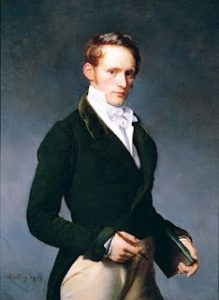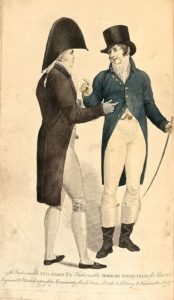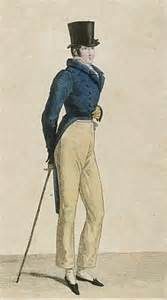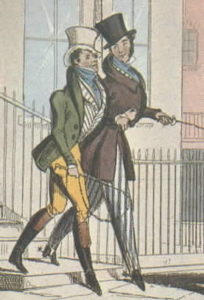 In Regency England, the term “coat” does not refer to outerwear. That article of clothing is called a greatcoat or overcoat. Instead, “coat” always referred to a tailcoat which was an indispensable part of every gentleman’s daily wear. Tailcoats were made from fine wool and finished with broadcloth, merino, or kerseymere.
In Regency England, the term “coat” does not refer to outerwear. That article of clothing is called a greatcoat or overcoat. Instead, “coat” always referred to a tailcoat which was an indispensable part of every gentleman’s daily wear. Tailcoats were made from fine wool and finished with broadcloth, merino, or kerseymere.

The Morning Coat or Riding Coat. This is the informal coat of a gentleman’s clothing. Its distinguishing characteristics are the front edges which slope to the round-edged tails in back. Generally, the tails of the riding coat were a little shorter than the walking coat but the lines on that distinction seem a bit blurry. A blue morning coat with buff or tan breeches was considered the epitome of fashionable casual wear. Other popular colors included olive, bottle-green, and even plum. Green and brown also show up frequently but those seem to be primarily for country living. Morning coats or riding coats were usually double-breasted, and could be customized with a pocket(s) in the back by the tails. Buttons in silver or brass seemed to be popular, based on the fashion plates I have studied.

The dress coat. Similar to day’s “tux and tails,” the dress coat was short through the trunk and cut straight across to allow the waistcoat to peek out below. It had long, square tails in back. This was fashionable and appropriate for formal occasions. Black was the most formal but I often see engravings of gray and blue as well, as shown in the picture to the right. Formal tailcoats were made of very fine wool and given a dress finish called “superfine.” Often the dress coats themselves were called simply “superfine.” Notice this gentleman to the right is wearing trousers would were just starting to emerge in the late Regency. Buttons were usually covered with matching cloth.

The Frockcoat. Often I find the term frockcoat used interchangeably with tailcoat and the term I used in most of my books I have written thus far. Recently, however, I discovered that the frockcoat belonged to the early Georgian Era and though it was re-introduced late in the Regency, didn’t gain popularity until the Victorian Era. The two stylish gentleman to the left are wearing Victorian frockcoats. The one on the far side is also wearing trousers, and the other is wearing breeches and riding boots, showing that transitional phase. By the late Victorian, knee breeches were pretty much only worn as riding attire. But I digress. The frockcoat had a full of skirt the same length all around and no tails. It also had room for pockets in the side. It opened down the front to reveal the waistcoat. This coat, like the morning or riding coat, was also made of very fine wool.
During the Regency, Georgian-style frockcoats were required court attire. They were very ornate, with brocade or heavy-embroidery such as what you see in pictures of George Washington and other Georgian-Era gentlemen. Court costume included trimming such as fur, ribbons, and gold or silver-threaded lace. Court frockcoats were not cut in at the waist but had a more square shape, and they had long elegant tails.
